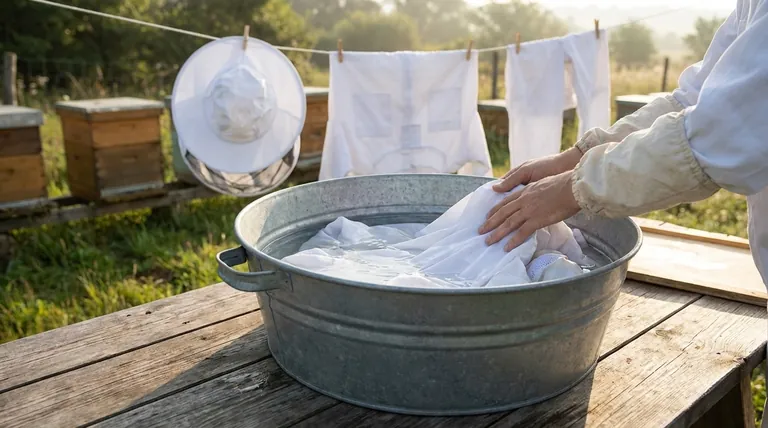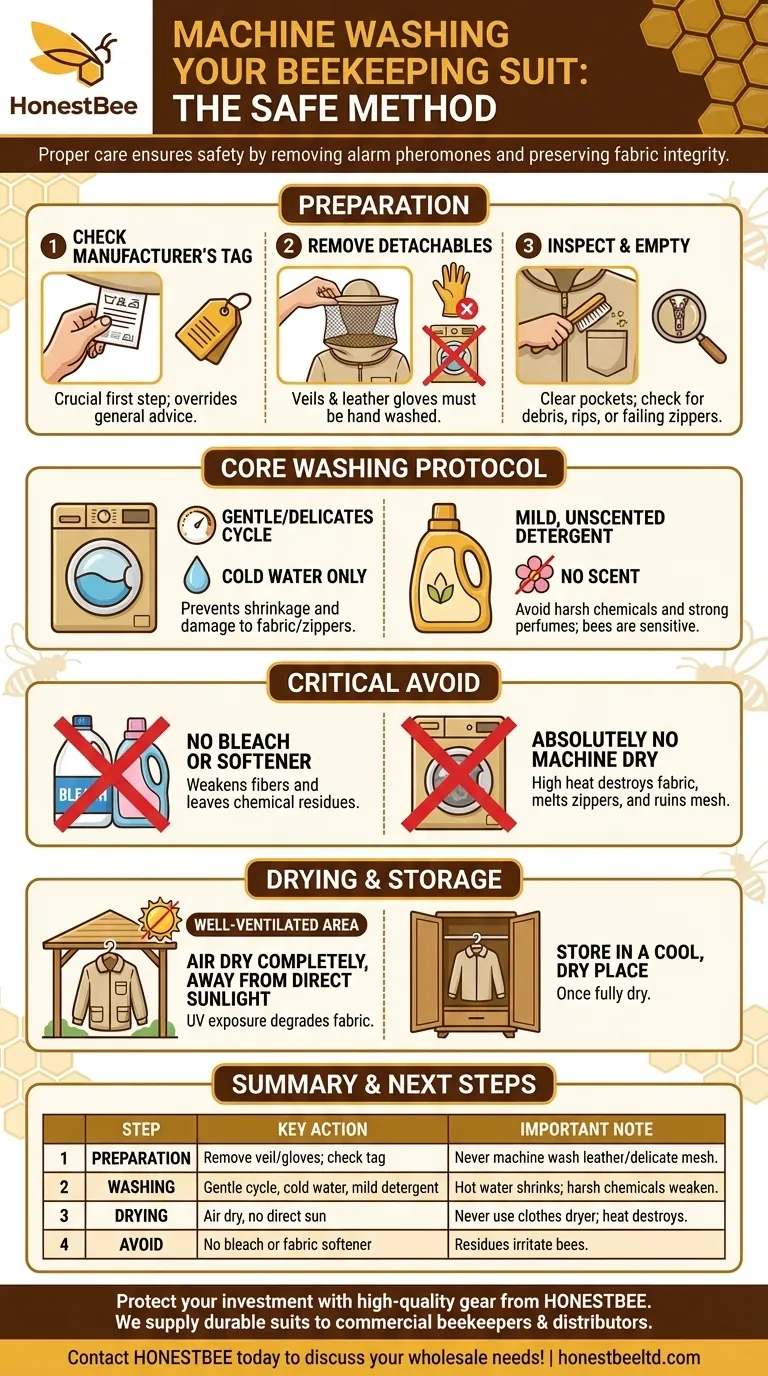To properly wash a beekeeping suit in a machine, you must use a gentle cycle with cold water and a mild, unscented detergent. Before washing, always remove any detachable components like the veil or leather gloves, as they should never be machine washed. Crucially, avoid all bleach and fabric softeners, as they can weaken the fabric's protective weave and leave behind chemical residues.
The goal of washing a bee suit is not just cleanliness, but safety. A proper wash removes residual alarm pheromones that can provoke bees, while a gentle drying process preserves the fabric's integrity, ensuring the suit remains a reliable protective barrier.

Preparing Your Suit for a Safe Wash
Before the suit ever touches the washing machine, a few preparatory steps are essential to protect both the suit and your other equipment.
Always Check the Manufacturer's Tag
The first and most important step is to confirm your suit is machine washable. While most modern suits are, the manufacturer's care label is the definitive guide and will override any general advice.
Remove All Detachable Components
Veils and leather gloves must be removed before washing. The delicate mesh of a veil can be easily torn in a machine, and leather will be irreversibly damaged by the water and detergent. These items should be cleaned separately by hand.
Inspect for Debris and Damage
Empty all pockets and brush off any loose debris. This is also the perfect time to inspect your suit for any rips, tears, or failing zippers that could compromise its integrity during your next hive inspection.
The Core Washing Protocol
Once prepared, the suit can be washed using a specific, gentle method designed to clean effectively without causing damage.
Use a Gentle Cycle with Cold Water
Select the gentle or delicates cycle on your washing machine. Always use cold water, as hot water can cause the fabric—especially cotton or cotton-blend suits—to shrink and can damage zippers and elastic.
Choose a Mild, Unscented Detergent
Use a small amount of mild laundry detergent. Harsh chemical cleaners can degrade the protective fibers of the suit over time. More importantly, avoid any detergents with strong perfumes or scents, as bees are highly sensitive to smells.
Understanding the Pitfalls: What to Avoid
What you don't do is just as important as what you do. Certain common laundry practices can ruin a bee suit.
Never Use Bleach or Fabric Softener
Bleach will severely weaken the fabric's fibers, creating potential weak points that a stinger could penetrate. Fabric softener leaves a chemical coating on the material that can attract dirt, reduce breathability, and potentially irritate or attract bees.
Absolutely Do Not Machine Dry
The high heat of a clothes dryer is the fastest way to destroy a bee suit. It will damage the fabric, melt plastic zippers, and can ruin the fine mesh on integrated veils. Never put your bee suit in a dryer.
The Critical Drying and Storage Process
After washing, hang the suit to air dry completely. Choose a well-ventilated area that is out of direct sunlight, as prolonged UV exposure can degrade and weaken the fabric over time. Once dry, store it in a cool, dry place.
Making the Right Choice for Your Routine
Your maintenance routine directly impacts your safety and the lifespan of your gear.
- If your primary focus is maximum safety: Wash your suit regularly to remove the alarm pheromones left by bee stings, which can trigger defensive behavior in a colony on subsequent visits.
- If your primary focus is suit longevity: Strictly adhere to the "no heat" rule by only using cold water washes and always air drying your suit away from direct sun.
Properly caring for your bee suit is a fundamental part of responsible and safe beekeeping.
Summary Table:
| Step | Key Action | Important Note |
|---|---|---|
| Preparation | Remove veil and gloves; check for damage. | Never machine wash leather or delicate mesh. |
| Washing | Use gentle cycle, cold water, and mild, unscented detergent. | Hot water can shrink fabric and damage zippers. |
| Drying | Always air dry away from direct sunlight. | Never use a clothes dryer; heat destroys the suit. |
| Avoid | No bleach or fabric softener. | These chemicals weaken fabric and can irritate bees. |
Protect your investment and ensure your safety with the right gear from the start. Proper suit maintenance is crucial, but it begins with high-quality equipment. HONESTBEE supplies durable beekeeping suits and essential apiary supplies to commercial beekeepers and distributors through our wholesale operations. Let us help you build a safer, more efficient operation. Contact HONESTBEE today to discuss your wholesale needs!
Visual Guide

Related Products
- Cotton Beekeeping Suit and Round Hat with Veil Bee Keeper Protective Gear
- Professional Beekeeping Suit for Kids and Girls Childrens Bee Keeper Suit
- White Beekeeping Protective Suit and Hat with Fencing Veil for Beekeepers
- Beekeeper Cowboy Hat and Veil for Beekeeping
- Heavy Duty Cowboy Beekeeper Hat with Visibility Veil Outdoor Professional Beekeeping Protective Gear
People Also Ask
- Do beekeeping suits completely prevent stings? Maximize Your Apiary Safety with the Right Gear
- What are the benefits of a fully ventilated beekeeping suit? Stay Cool and Protected in Hot Climates
- What factors should be considered when choosing a beekeeping suit? Balance Safety, Comfort & Performance
- What are bee suits made of? Choosing the Right Material for Maximum Protection & Comfort
- What is recommended for beginners in beekeeping regarding protective clothing? A Complete Safety Guide for New Beekeepers



















